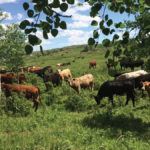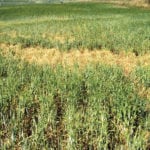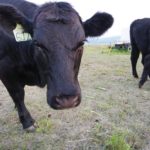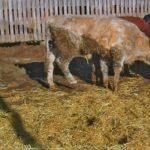
Hay

Tips for baling in high-moisture situations
Forages: News Roundup from the May 2019 issue of Canadian Cattlemen
In the last issue, we outlined Ryan Sommerfeld’s methods for deciding when to cut hay to minimize rain damage. Sommerfeld is a cattle producer based near Medstead, Sask. Now we turn to Sommerfeld’s methods for cutting, raking and baling. Sommerfeld prefers cutting with a 13.5-foot discbine, which allows him to cut at about six miles […] Read more

Making good hay
If you follow the principles of making hay, you can also grow good pasture
If you follow the principles of making hay, you can also grow good pasture
My wife and I recently attended the Alberta Organic Conference in Fort Saskatchewan. It was a fantastic event and she made a great comment to me on the way home. We attend a lot of events like this and we are constantly reminded about the principles of regenerative agriculture. It’s “the normal” in our circle. […] Read more
Bale grazing. ‘What a waste of feed!’ NO
Grazing with Steve Kenyon
I still receive this comment quite often when I speak about bale grazing. Our industry is hung up on being efficient. We don’t want to waste anything. I know we have all been trained to target 97 per cent efficiency in everything we do. But I would rather be effective. Most of our efficiencies come from looking at […] Read more

Be prepared for nitrate problems in forages
High nitrite levels in cattle can literally see them 'starving for oxygen'
Nitrate levels in forages can sometimes be a problem for cattle. Depending on growing conditions, certain plants may accumulate too much nitrate to be safely fed to cattle unless those high-nitrate feeds can be diluted by mixing with other forages. Colby Elford, livestock and feed extension specialist, Ministry of Agriculture, Moose Jaw, Sask., says it […] Read more

Four options to help deal with a feed shortage
What is your best option if you’re short on feed? “Each farm is different and therefore doing your numbers as they pertain to your situation is paramount,” said provincial economics extension specialist Herman Simons. “In addition, each option has different pros and cons, which should be listed and taken into account when determining the best[...]
Read more
Read more

Livestock producers allowed to cut hay, graze on Manitoba Crown lands
Areas will be temporarily open to assist producers impacted by dry conditions
Livestock producers will temporarily be allowed to cut hay and allow animals to graze on Crown land not normally designated for agricultural use due to dry conditions across parts of the province, Manitoba Agriculture Minister Ralph Eichler announced today. “Pastures and forage crops in parts of Manitoba have been greatly affected by low levels of[...]
Read more
Read more

Straw prices soar, piling pressure on N.Europe livestock farmers
In some areas straw now more expensive than grains
Hamburg | London | Reuters – Livestock and dairy farmers across northern Europe are paying soaring prices for straw used in food and bedding for cattle, as hot, dry weather across the region reduces crops. The higher bills put further pressure on farmers already facing one of their toughest summers ever; many have had to[...]
Read more
Read more

Why baling hay and hot weather don’t mix
Uneven yields up the risk of mouldy, heated feed, while leaf loss increases when the temperature soars
This year is going to be a challenge deciding when to bale hay, says provincial beef and forage specialist Barry Yaremcio. “With yield differences in a field, areas with a low yield will be dry and ready to bale while areas of that field with higher yield potential may need more time to dry and[...]
Read more
Read more

Prairie hay crops look thin in many areas
CNS Canada — Many farmers taking off their first hay cuts are also gathering more talking points to grumble over at coffee row. While many producers are still working to get the first cut done and the situation could change with the second cut, many regions are already reporting below-average yields. “In areas of the[...]
Read more
Read more

Ergot poisoning: An ancient scourge remains a problem in modern rations
Vet Advice with Dr. Ron Clarke
The negative impacts of ergot contamination in food were recognized as early as the fifth century AD. Ergot, a plant parasite, commonly affects rye grass, but wheat, rye, barley, oats, brome, fescue, blue, timothy, western and intermediate wheatgrass and other grasses can also be infected. Environmental conditions associated with a cool wet spring followed by[...]
Read more
Read more



